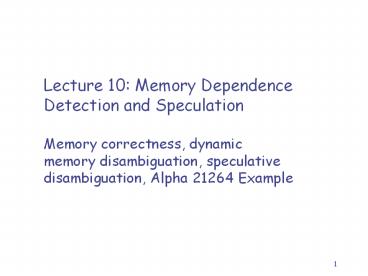Lecture 10: Memory Dependence Detection and Speculation PowerPoint PPT Presentation
Title: Lecture 10: Memory Dependence Detection and Speculation
1
Lecture 10 Memory Dependence Detection and
Speculation
- Memory correctness, dynamic memory
disambiguation, speculative disambiguation, Alpha
21264 Example
2
Register and Memory Dependences
- Store SW Rt, A(Rs)
- Calculate effective memory address ? dependent on
Rs - Write to D-Cache ? dependent on Rt, and cannot be
speculative - Compare ADD Rd, Rs, Rt
- What is the difference?
- LW Rt, A(Rs)
- Calculate effective memory address ? dependent on
Rs - Read D-Cache ? could be memory-dependent on
pending writes! - When is the memory dependence known?
3
Memory Correctness and Performance
- Correctness conditions
- Only committed store instructions can write to
memory - Any load instruction receives its memory operand
from its parent (a store instruction) - At the end of execution, any memory word receives
the value of the last write - Performance Exploit memory level parallelism
4
Load/store Buffer in Tomasulo
- Original Tomasulo Load/store address are
pre-calculated before scheduling - Loads are not dependent on other instructions
- Stores are dependent on instructions producing
the store data - Provide dynamic memory disambiguation check the
memory dependence between stores and loads
IM
Fetch Unit
Reorder Buffer
Decode
Rename
Regfile
RS
RS
L-buf
S-buf
DM
FU1
FU2
5
Dynamic Scheduling with Integer Instructions
IM
- Centralized design example
- Centralized reservation stations usually include
the load buffer - Integer units are shared by load/store and ALU
instructions - What is the challenge in detecting memory
dependence?
Fetch Unit
Reorder Buffer
Decode
Rename
Regfile
Centralized RS
FU
FU
I-Fu
I-FU
addr
data
S-buf
addr
data
D-Cache
6
Load/Store with Dynamic Execution
- Only committed store instructions can write to
memory - ? Use store buffer as a temporary place for write
instruction output - Any memory word receives the value of the last
write - ? Store instructions write to memory in program
order - Any load instruction receives its memory operand
from its parent (a store instruction) - Memory level parallelism be exploited
- ? Non-speculative solution load bypassing and
load forwarding - ? Speculative solution speculative load execution
7
Store Buffer Design Example
- Store instruction
- Wait in RS until the base address and data are
ready - Calculate address, move to store buffer
- Move data directly to store buffer
- Wait for commit
- If no exception/mis-predict
- Wait for memory port
- Write to D-cache
- Otherwise flushed before writing D-cache
RS
I-FU
From RS
addr
data
Ry
C
young
0
0
1
0
Arch. states
-
1
-
1
old
To D-Cache
8
Memory Dependence
- Any load instruction receives the memory operand
from its parent (a store instruction) - If any previous store has not written the
D-cache, what to do? - If any previous store has not finished, what to
do? - Simple Design Delay all following loads but how
about performance?
9
Memory-level Parallelism
- Significant improvement from sequential
reads/writes
- for (i0ilt100i)
- Ai Ai2
- Loop L.S F2, 0(R1)
- MULT F2, F2, F4
- SW F2, 0(R1)
- ADD R1, R1, 4
- BNE R1, R3,Loop
Read
Read
Read
Write
Write
Write
10
Load Bypassing and Load Forwarding
- Non-speculative solution
- Dynamic Disambiguation Match the load address
with all store addresses - Load bypassing start cache read if no match is
found - Load forwarding using store buffer value if a
match is found - In-order execution limitation must wait until
all previous store have finished
RS
Store unit
I-FU
I-FU
match
D-cache
11
In-order Execution Limitation
- Example 1 When is the SW result available, and
when can the next load start? - Possible solution start store address
calculation early ? more complex design - Example2 When is the address a-gtb-gtc
available?
Example 1 for (i0ilt100i) Ai
Ai/2 Loop L.S F2, 0(R1) DIV F2, F2, F4 SW
F2, 0(R1) ADD R1, R1, 4 BNE R1,
R3,Loop Example 2 a-gtb-gtc 100 d x
12
Speculative Load Execution
- If no dependence predicted
- Send loads out even if dependence is unknown
- Do address matching at store commits
- Match found memory dependence violation, flush
pipeline - Otherwise continue
- Note may still need load forwarding (not shown)
RS
I-FU
I-FU
match
load-q
store-q
D-cache
13
Alpha 21264 Pipeline
14
Alpha 21264 Load/Store Queues
Int issue queue
fp issue queue
AddrALU
IntALU
IntALU
AddrALU
FPALU
FPALU
Int RF(80)
Int RF(80)
FP RF(72)
D-TLB
L-Q
S-Q
AF
Dual D-Cache
32-entry load queue, 32-entry store queue
15
Load Bypassing, Forwarding, and RAW Detection
commit
match at commit
Load/store?
ROB
head
Load WAIT if LQ head not completed, then move LQ
head Store mark SQ head as completed, then move
SQ head
store-q
load-q
load addr
store addr
committed
If match forward
D-cache
If match mark store-load trapto flush pipeline
(at commit)
16
Speculative Memory Disambiguation
PC
1024 1-bitentry table
Renamed inst
1
int issue queue
- To help predict memory dependence
- Whenever a load causes a violation, set stWait
bit in the table - When the load is fetched, get its stWait from the
table, send to issue queue with the load
instruction - A load waits there if its swWait is set and any
previous store exists - The tale is cleared periodically
17
Architectural Memory States
LQ
SQ
Committed states
Completed entries
L1-Cache
L2-Cache
L3-Cache (optional)
Memory
Disk, Tape, etc.
- Memory request search the hierarchy from top to
bottom
18
Summary of Superscalar Execution
- Instruction flow techniques
- Branch prediction, branch target prediction, and
instruction prefetch - Register data flow techniques
- Register renaming, instruction scheduling,
in-order commit, mis-prediction recovery - Memory data flow techniques
- Load/store units, memory consistency
- Source Shen Lipasti reference book

